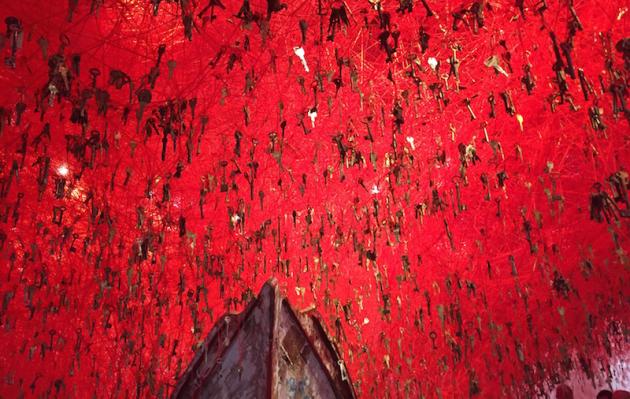When I visited Chiharu Shiota’s studio a year ago in Berlin, she had just been invited to represent Japan at the Venice Biennale along with the curator Nakano Hitoshi who organised a solo exhibition of her work in Kanagawa in 2007. She was truly honoured and mentioned that representing Japan in Venice has always been one of her dreams.
One year later, visiting the Japanese pavilion in Venice I can’t help remembering this moment and thinking that she succeeded in creating not only a truly beautiful piece but an artwork which relates to the viewer and engages the public emotionally. Everyone who has visited the Giardini refers to Shiota’s work, falling under the spell of her magical red threads.

Her installation, entitled The Key in the Hand, consists of two boats, red yarn, and a huge number of keys: 50,000 keys that the artists has been collecting from the public. For several months people had been sending her keys from all over the world. The large-scale installation fills up the Japanese pavilion with red yarn by stretched across the exhibition space and up to the ceiling. There is a key attached to the end of each piece of yarn, suspended from the ceiling. In addition, there are two rustic boats on the floor beneath the yarn and the hanging keys. There is also an accompanying video of children trying to summon their earliest memories.

Memories take centre stage in Chiharu Shiota’s work. The spatial structure in the Japanese pavilion: this maze of red yarn, does not reflect as strongly the sense of darkness which has prevailed in Shiota’s previous major installations, maybe because the artist interacts with the viewers. By inviting the public to contribute to the work by sending their own keys, the artist explores the notion of multilayered memories. It is the first time that she intertwines the memories of each key owner together with her own memories. She successfully creates a work where she establishes a communication with the public. The keys become the medium that conveys our true feelings. “Keys are familiar and very valuable things that protect important people and spaces in our lives,” said Shiota.

In a highly political biennale where readings of Das Capital takes place everyday, Chiharu Shiota offers us a work which transcends political, sociological and religious differences and debates. It is both highly aesthetic and beautiful and has an intense meditative atmosphere to it, touching the human soul. As Nakano Hitoshi, the curator, says, what is at stake are “pure and sublime art”.
Words/Top Photo: Virginie Syn © Artlyst 2015 Additional Photos P C Robinson

